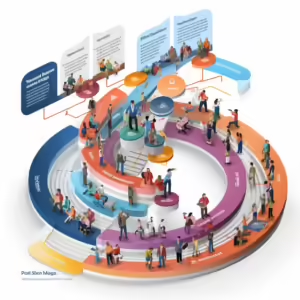ITIL: A framework for effective IT service management
ITIL, short for Information Technology Infrastructure Library, is an established IT service management (ITSM) framework that aims to optimize and standardize the delivery of IT services. Originally developed by the British government, ITIL has established itself as a global standard in the IT industry. This article provides an overview of ITIL, its main components and benefits to organizations.
What is ITIL?
ITIL is a framework that includes best practices, processes and procedures for the efficient management of IT services. It provides guidelines on how to organize, plan and execute IT operations to increase efficiency and provide better service.
Core components of ITIL
ITIL consists of a series of publications that cover various aspects of IT service management:
- Service strategy: Development of an approach to control and improve IT services.
- Service design: Planning and design of IT services and processes to meet company goals.
- Service transition: Implementation of IT services in the operating environment.
- Service Operations: Effective and efficient provision of IT services.
- Continuous service improvement: Continuously review and improve service quality and efficiency.
Advantages of ITIL
- Improved service quality: Through standardization and best practices.
- Increased efficiency: Through clear processes and guidelines.
- Better customer focus: Focus on aligning IT services with business goals.
- Risk mitigation: Through standardized procedures for managing and resolving problems.
- Cost efficiency: Optimize resource utilization and reduce waste.
Implementation of ITIL
Implementing ITIL in an organization requires:
- Understanding ITIL Principles: Familiarization with ITIL practices and procedures.
- Adaptation to business needs: Apply ITIL principles according to the specific needs of the organization.
- Training and Certification: Promote ITIL competency within IT teams through training and certification.
- Continuous improvement: Regular review and adjustment of ITIL-based processes.
Challenges in implementing ITIL
- Initial investment: time and resources required to implement ITIL.
- Resistance to Change: Challenges in Changing Existing Processes and Habits.
- Need for customization: ITIL is not a “one-size-fits-all” approach and must be customized to the specific needs of the organization.
Conclusion
ITIL provides a comprehensive and flexible IT service management framework that helps organizations make their IT services more efficient and effective. By implementing ITIL, companies can optimize their IT operations, improve service quality and achieve greater business value. Despite the challenges associated with adopting such a framework, ITIL offers sustainable benefits for efficient and effective IT service delivery.





